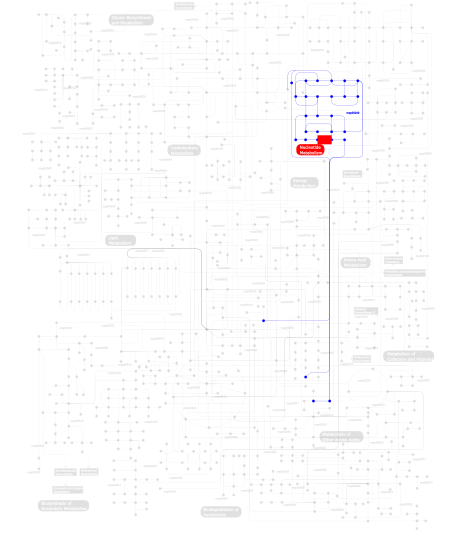The domain within your query sequence starts at position 1239 and ends at position 1358; the E-value for the A1pp domain shown below is 6.82e-20.
LFQVATGNIIKEVADVIVNSTTLTFDLKSGVSKAILEGAGQNVEQECSLLAKQSNHGYIV TGGGLLQCKNIIHVVGGNDVKKSVSCVLEECEQRNYSSICLPAIGTGNAQQDPNVVAKAI
A1ppAppr-1"-p processing enzyme |
|---|
| SMART accession number: | SM00506 |
|---|---|
| Description: | Function determined by Martzen et al. Extended family detected by reciprocal PSI-BLAST searches (unpublished results, and Pehrson & Fuji). |
| Interpro abstract (IPR002589): | The Macro or A1pp domain is a module of about 180 amino acids which can bind ADP-ribose (an NAD metabolite) or related ligands. Binding to ADP-ribose could be either covalent or non-covalent [ (PUBMED:16959969) ]: in certain cases it is believed to bind non-covalently [ (PUBMED:18983849) ]; while in other cases (such as Aprataxin) it appears to bind both non-covalently through a zinc finger motif, and covalently through a separate region of the protein [ (PUBMED:18172500) ]. The domain was described originally in association with ADP-ribose 1''-phosphate (Appr-1''-P) processing activity (A1pp) of the yeast YBR022W protein [ (PUBMED:10550052) ]. The domain is also called Macro domain as it is the C-terminal domain of mammalian core histone macro-H2A [ (PUBMED:11343911) (PUBMED:12842467) ]. Macro domain proteins can be found in eukaryotes, in (mostly pathogenic) bacteria, in archaea and in ssRNA viruses, such as coronaviruses [ (PUBMED:21525212) (PUBMED:31095648) ], Rubella and Hepatitis E viruses. In vertebrates the domain occurs e.g. in histone macroH2A, in predicted poly-ADP-ribose polymerases (PARPs) and in B aggressive lymphoma (BAL) protein. The macro domain can be associated with catalytic domains, such as PARP, or sirtuin. The Macro domain can recognise ADP-ribose or in some cases poly-ADP-ribose, which can be involved in ADP-ribosylation reactions that occur in important processes, such as chromatin biology, DNA repair and transcription regulation [ (PUBMED:15902274) ]. The human macroH2A1.1 Macro domain binds an NAD metabolite O-acetyl-ADP-ribose [ (PUBMED:15965484) ]. The Macro domain has been suggested to play a regulatory role in ADP-ribosylation, which is involved in inter- and intracellular signaling, transcriptional regulation, DNA repair pathways and maintenance of genomic stability, telomere dynamics, cell differentiation and proliferation, and necrosis and apoptosis. The 3D structure of the SARS-CoV Macro domain has a mixed alpha/beta fold consisting of a central seven-stranded twisted mixed beta sheet sandwiched between two alpha helices on one face, and three on the other. The final alpha-helix, located on the edge of the central beta-sheet, forms the C terminus of the protein [ (PUBMED:16912299) ]. The crystal structure of AF1521 (a Macro domain-only protein from Archaeoglobus fulgidus) has also been reported and compared with other Macro domain containing proteins. Several Macro domain only proteins are shorter than AF1521, and appear to lack either the first strand of the beta-sheet or the C-terminal helix 5. Well conserved residues form a hydrophobic cleft and cluster around the AF1521-ADP-ribose binding site [ (PUBMED:12842467) (PUBMED:15902274) (PUBMED:15965484) (PUBMED:16912299) ]. |
| Family alignment: |
There are 16662 A1pp domains in 14754 proteins in SMART's nrdb database.
Click on the following links for more information.
- Evolution (species in which this domain is found)
- Literature (relevant references for this domain)
- Metabolism (metabolic pathways involving proteins which contain this domain)
- Structure (3D structures containing this domain)
- Links (links to other resources describing this domain)























































































